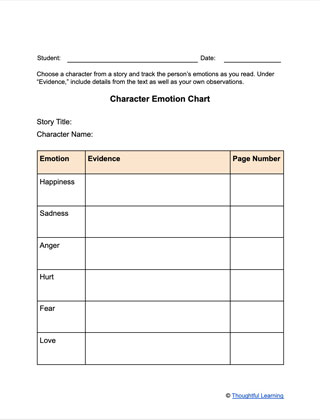Novels and short stories are filled with emotions. The characters in them experience the ups and downs of the human condition, often in dramatic fashion. And as we read along, we feel things, too—about the characters and ourselves. For these reasons, literature offers a gateway to social-emotional learning in your classroom.
When students analyze the emotions of the characters they are reading about, they gain not only a greater understanding of the text but also a greater understanding of their own emotions.
Use these activities from In Focus to have students identify, respond to, and learn from the emotions presented in the stories they read.
Activity 1: Emotions in Literature
- Have students silently read stories or novels for 15–20 minutes.
- Hand out a character emotion chart for students to fill in while they read.
- After students read, post the following reflection questions:
- What emotion do you think the character is feeling right now and why do you think that?
- How does the character choose to express her or his emotions? Is it a healthy and productive way?
- How do the characters’ emotions influence their actions and decisions?
- Give students 5–10 minutes to respond to the questions, perhaps writing in a journal or reading notebook, or filling in their character emotion chart.
- After a few sessions focused on characters' emotions, have students reflect on their own emotions.
- How are you feeling about what is happening in the story and why?
- How would you feel in that situation and why?
- How does your emotional reaction to the scene influence the way you view the characters?
- After reading, ask for volunteers to share their responses.
Activity 2: Emotions Skit
- Ask students to silently read stories or novels for 15–20 minutes. As they do, they should mark dialogue that shows conflict between two characters.
- After reading, have students write out the dialogue of the characters in conflict.
- Have pairs of volunteers study the dialogue and act it out with expression.
- Ask the rest of the class to observe the conflict skits and reflect on these questions:
- What emotions do the characters display?
- How do the characters deal with their conflict?
- Do you agree with the characters’ approach?
- What alternative solution for the conflict might have worked better?
- If time permits, invite students to act out the alternative solutions.
Featured Download: Character Emotion Chart
Download a PDF
Copy the Google Doc
Teaching Support
Consider this support as your students analyze emotions in literature.
Level
1–8
Learning Objectives
By completing this activity, students will . . .
- Describe the relationship between a character's emotions and actions.
- Demonstrate awareness of other people's emotions and perspectives.
- Self-monitor their own feelings.
- Demonstrate knowledge of healthy ways of dealing with conflict.
- Draw evidence from literature to support and reflect on theme and character development in fiction.
- Identify diverse social norms, including unjust ones.
Teaching Tips
- If you are reading out loud as a class, present quick directives about the six primary emotions: Raise your hand if you are feeling happy right now. Now raise your hand if you are feeling sad. Continue the activity with the remaining emotions: fear, anger, hurt, and love. Afterward, provide students time to elaborate on the emotions they feel.
- Repeat the emotions skit activity for other reading assignments, providing different students opportunities to act out the scenes.
- Expose students to literature with diverse characters, situations, and settings. Students need to see themselves in what they read, but they also need to see others and experience differing perspectives. Through diverse literature, students grow empathy and understanding.
- Review the SEL framework from the Collaborative for Academic, Social, and Emotional Learning (CASEL).
